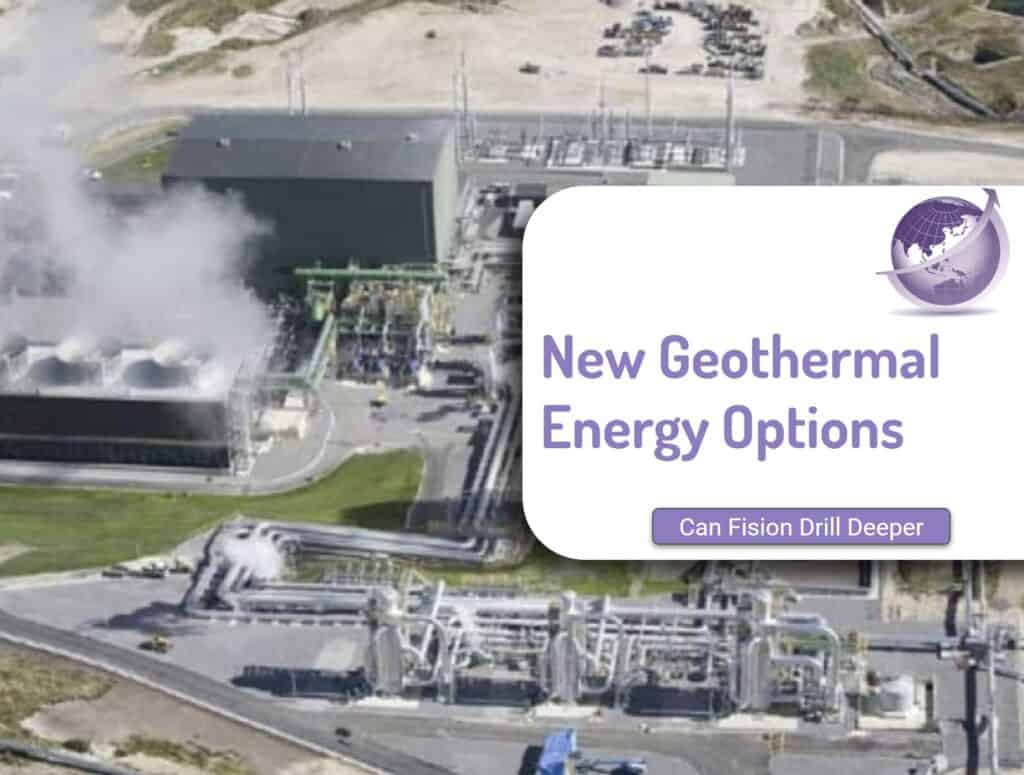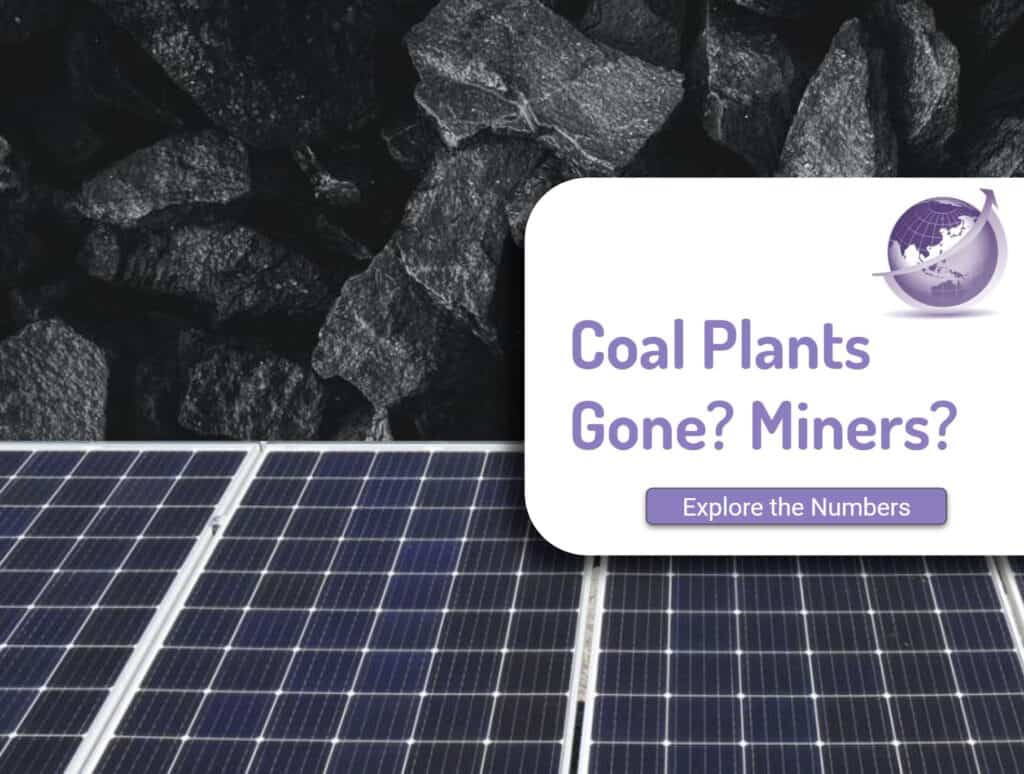Everyone knows the Earth’s core is hot, and even at the surface humans have used the geothermal energy for heating and electricity generation. But maybe the scale of it still has the power to surprise. Temperatures in the iron centre of the core are estimated to be around 5,200 °C (9,392 °F), generated by heat from radioactive elements decaying combining with heat that still remains from the very formation of the planet – an event of cataclysmic violence when a swirling cloud of gas and dust was crushed into a ball by its own gravity.
Where there’s access to heat, there’s harvestable geothermal energy. And there’s so much heat below the Earth’s surface, according to Paul Woskov, a senior fusion research engineer at MIT, that tapping just 0.1 percent of it could supply the entire world’s energy needs for more than 20 million years. Net Zero emissions using renewable energy can be achieved with less than 2% of GDP expenditure.
Exciting Geothermal Opportunity
Features include:
- Uses latest, smartest, drilling technology in the solid rock
- Uses 50 year old high powered, plasma technology, spallation, from fission research to drill to necessary depths
- Faster by 10 times
- Uses stranded assests (fossil fuel plant steam turbines) to generate the electricity
- Co-located with existing power plants (which have grid connection
- Low research risk
- Short term (by 2026) to be 100 MW scale systems and full systems by 2030.
Conventional Geothermal Energy
Geothermal electricity generation is currently used in 26 countries, while geothermal heating is in use in 70 countries. As of 2019, worldwide geothermal power capacity amounted to only 15.4 gigawatts (25% of Australians demand). Whether in the North Island of New Zealand, in Iceland, Japan, Germany, Mexico, USA, shallow bores provide steam to heat cities, to generate electricity providing an unlimited amount of infinite renewable energy. But these plants are often not very economic as the amount of heat recovered is relatively low.
Fusion Drilling Technology
Will new technology unlock near-limitless ultra-deep geothermal energy? A new company Quaise believes it can. reported by New Atlas. Fusion is the technology to create nuclear reactions and ITER Tokamak is the most complex experiment with over 35 nations trying to crack the technology for the generation of energy. Others trying to do the same. A bit of engineering, used in these fusion experiments is a gyrotron A gyrotron produces high power millimeter waves, which are transmitted to the downhole environment with high efficiency via a single waveguide. There are patents from 2008, and it has been looked at for oil and gas. But using it for geothermal is novel.
Millimeter wave drilling will unlock the most abundant and powerful clean energy source on Earth by allowing us to drill down to 20 km and 500° C.
Quaise Energy 2022
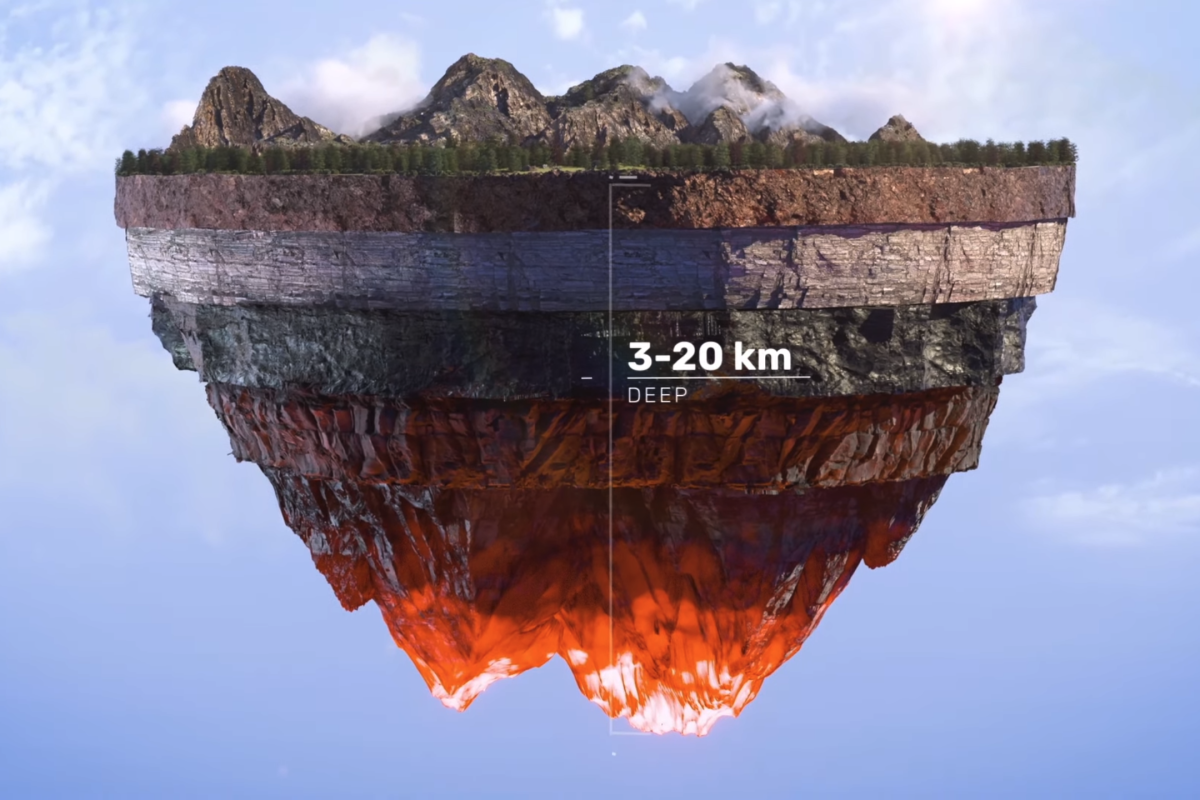
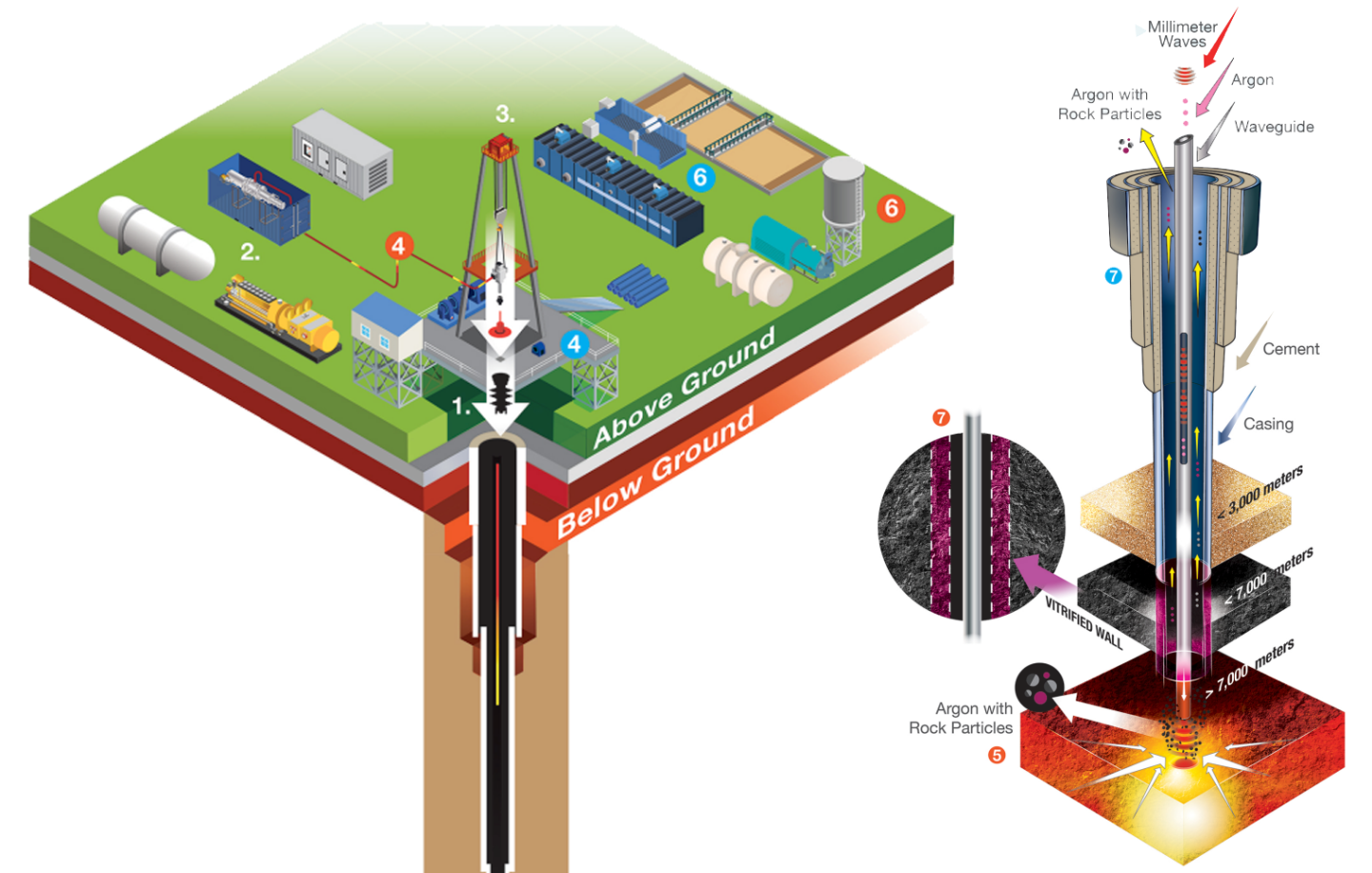
Quaise Technology Q&Q
Quaise says “If we could drill deep enough, we could put geothermal power stations just about anywhere we wanted them.”
But that’s harder than it sounds. The Earth’s crust varies in thickness between about 5-75 km. Drilling to these depths using conventional methods does not work and is very expensive. Where conditions become too difficult for physical drill bits to operate, Quaise and researchers since the 1990s have been testing the capabilities of directed energy beams to heat, melt, fracture and even vaporize basement rock in a process called spallation, before the drill head even touches it.
A direct-energy drill would effectively cauterize the rock it cut through, melting the bore shaft as it goes and vitrifying it into a glassy layer that would seal out fluids, gases and other contaminants that have caused problems in previous ultra-deep drilling projects. Continuous megawatt power millimetre-waves can also be efficiently (>90%) guided to great distances (>10 km) using a variety of modes and waveguide (pipes) systems, including the potential of using smooth bore coiled and jointed/ joined tubing.
Quaise says their gyrotron-powered drilling platform vaporizes boreholes through rock and provides access to deep geothermal heat without complex downhole equipment. Based on 50 years of breakthrough fusion research and well-established drilling practices, they are developing a radical new approach to ultra-deep drilling. First, they use conventional rotary drilling to get to basement rock. Then, they switch to high-power millimetre waves to reach unprecedented depths.
Their intent is to use conventional steam turbines in existing fossil fuel power stations.
Questions Answered
Check out this New Atlas Q&A (https://newatlas.com/energy/quaise-deep-geothermal-drilling-questions)
- Willl a flow of supercritical water provide enough pressure to keep the bore open. Yes.
- Is it possible for water to enter the bore. No
- Will earthquakes cut off the bore. Unlikely. They do not disrupt oil wells
- How long will they last? 50 to 100 years
- Will the rock flow? No. Magma in the mantle is much deeper.
- Will this release magma. No. Solidifies
- Will this contribute to global warming. No
- Can this work for shallow holes as well. Yes
- Will there be seismic events. No. Not fracking
- Will gas be ignited. No. Use conventional drilling in gas rocks
- Will it be corrosive. Yes. But systems exist today
- How long to drill? 100 days.
- Read the rest of the FAQs. About lizards and Krypton.
Timeline
- 2024. First full-scale hybrid drilling rig combining conventional rotary drilling and millimeter wave drilling capabilities.
- 2026 First Super Hot Enhanced Geothermal System rated to 100 MW of thermal energy from a handful of wells.
- 2028 First fossil-fired power plant repowered with clean geothermal steam.
Out of MIT, funded with a $12m round.
What is the Economic Value To a Fossil Fuel Power Station?
- Number of coal power plants = 8500
- Cost of coal = $170 per tonne
- 1 tonne coal = 2,460 kWh of electricity
- Average 0.5 GW power = produces 3.5 billion KWhr per year
- Average 0.5 GW uses 1.5m tonnes coal
- Cost of fuel per year = 1.5m x 170 = $225m
Hot Rocks tried this back in 2006 but they were shallow drilling and were remote and not existing steam turbines.
Anything that rescues stranded assets (e.g. carbon capture) will be pounced on. Coal plants have grid connections. Land. Experience in steam. So they stop burning rocks. (Which humans have done for million years).
This is technology. But if it works, it’s a lifeline to every single fossil fuel power plant globally. If it costs less than $225m to provide that 0.5GW capacity then there is a capital cost, and maybe normal maintenance of the power plant. But fuel cost zip. Nada.
The alternative is closure. Wipe out of capital. Investment in renewables to retain customers.
Does it work?
Conventional Deep Geothermal Drilling
Deep geothermal drilling has been tried over the past 40 years and not been successful, but companies and researchers are trying it again using knowledge and expertise from fracking for oil and gas over the past 2 decades.
| Company | Website | Key Technology | Notes |
|---|---|---|---|
| Fervo | Fervo.com | fracking with hot water | using hydraulic fracking and sensors. Use pressure to create a battery like energy |
| Alta Rock Energy | AltaRock Energy | Deep drilling and sealing of drill holes <7km conventional >15-20km plasma or microwave | Wells need to last 20+ years unlike oil and gas (5) |
| The Utah Frontier Observatory for Research in Geothermal Energy (FORGE) | https://utahforge.com/ | High deviated – angled down at 65 degrees, temp at 440F | Sponsored by US Energy Second deep deviated well in doublet pair. A highly deviated well drilled in hard, hot crystalline granite – will mirror previously drilled injection well. Total length of the well will be approximately 10,700 feet. |
| Eavor | https://www.eavor.com/ | Fracking Closed loop. Use hotwater for communities Uses thermosiphoning rather than pumps | Have 2 demonstrations (Western Alberta with 2 pipes) in 2019, and a second one in 2022 which goes deeper with more pipelines |
- In 1983, scientists from the Department of Energy’s (DOE’s) Los Alamos National Laboratory on a pioneering attempt to exploit hot, dry rock in New Mexico’s Jemez Mountains. They injected water into deep fractures and then channelled the heated water back to the surface via a nearby exit well. But much of the injected water never resurfaced; researchers later concluded that they had misread the underlying geology, and the water disappeared into undetected cracks.
- Geodynamics closed its geothermal power test project in the Cooper Basin in Australia in 2015 after investing $144 million. Water pumped into the wells flowed into a previously unknown fault, and the project shut down after just 5 years.
- Unit of Utah is trying again with a $218 million project, 4 years in the making, known as FORGE (Frontier Observatory for Research in Geothermal Energy). the hole is 3.3km deep, 22cm wide, lined, and uses fracking technology from the oil and gas industry.
More than 20 geothermal companies have emerged since 2020 in USA. In Germany, the Helmholtz Association of German Research Centers announced in June it is putting €35 million into a new underground laboratory dedicated to geothermal research in deep crystalline rock, including EGS. And DOE in April 2022 announced plans to spend $84 million on four EGS pilot projects. They’ll be placed in different geological settings in the United States to study the best ways to extract heat from different types of rock.

Deep Well Geothermal
Eavor Technologies is using a similar approach, but drilling using a fracking approach. Instead of using fracking, they drilll through the rock layers and then seal with a chemical process.
- Provides heat for communities
- Flexible baseload power – can ramp up or down.
- Have 2 demonstrations (Western Alberta with 2 pipes) in 2019, and a second one in 2022 which goes deeper with more pipelines
- Fewer limitations. Not searching for a resource. Can go to where you need the resource.
- Predictable and reliable
- District heating – replace fossil fuel heats with a geothermal plant.
- Says 8 to 10 projects at project close
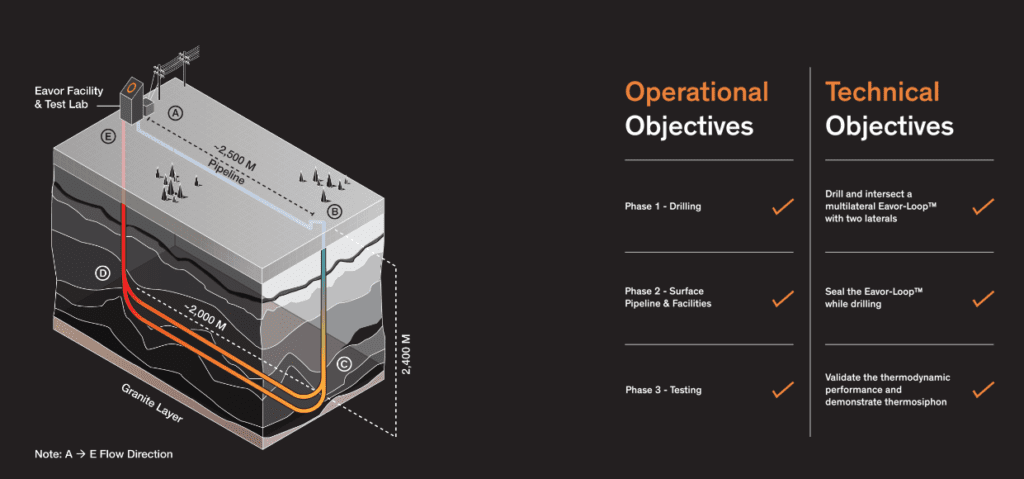
Fervo Energy
The CEO came from the gas fracking industry
- Uses deep-rock fracking
- Geothermal dispatchable generation electricity – providing load following
- Funded by Google
- Installs fiber optic cables downhole in our geothermal wells
- Using analysis of real-time data on flow, temperature, and performance of the resource and provides unique insights into subsurface behavior at a resolution never before possible.
- Fervo Energy tested one such system in 2023 in Nevada and proved its commercial viability.
- Building another project in Utah, to provide constant, clean power by 2026.
Read more at Fervo.
USA Dept of Energy Enhanced Geothermal Systems (ESG)
The Office of Energy Efficiency and Renewable Energy is funding an “Enhanced Geothermal Shot“. The Enhanced Geothermal Shot™ is a department-wide effort to dramatically reduce the cost of EGS by 90%, to $45 per megawatt hour by 2035. Investments in EGS can unlock affordable clean energy for over 65 million American homes and exponentially increase opportunities for geothermal heating and cooling solutions nationwide.


USA Investing in New Opportunities
As part of the IRA, the USA DoE announced in Feb 2024 $60m in additional funding.
The three projects are:
- Chevron New Energies—This EGS pilot demonstration will use innovative drilling and stimulation techniques to access geothermal energy near an existing geothermal field in Sonoma County in northern California.
- Fervo Energy—This pilot within the Milford Renewable Energy Corridor in Utah and adjacent to the DOE’s Frontier Observatory for Research in Geothermal Energy (FORGE) field laboratory aims to produce at least 8 megawatts of power from each of three wells at a site with no existing commercial geothermal power production.
- Mazama Energy—This project will demonstrate a first-of-its-kind super-hot EGS (temperatures above 375°C) on the western flank of Newberry Volcano in Oregon. This demonstration will help advance the science needed to operate in extreme heat conditions.
More Reading
- Biden–Harris Admin Invests $60 Million to Expand Clean, Renewable Geothermal Energy Feb 2024 Cleantechnica

